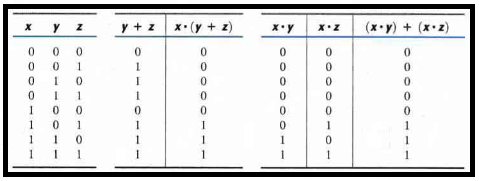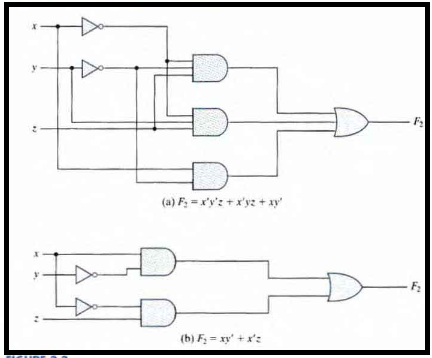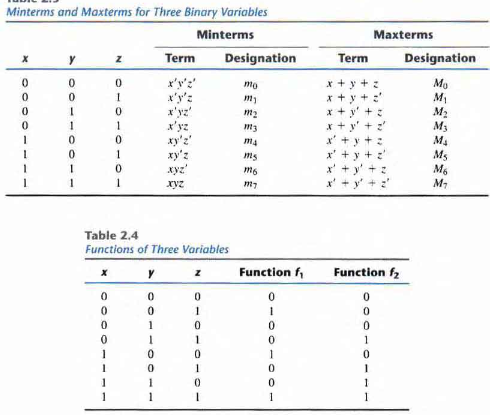INTRODUCTION
A set of elements is any collection of object s usually having a common property. It is denoted by y ∈ S or y ∉ S
A set with a denumerable number of elements is specified by braces: A = {1, 2, 3, 4} indicates that the elements of set A are the numbers 1, 2, 3, and 4
Closure: The set of natural numbers N = {1,2,3,4...} is closed with respect to operator '+' as for any a,b ∈ N there exists a unique c ∈ N such that a + b = c. Similarly the set of N is not Closed with respect to operator '-' as 2 - 3 = -1 which ∉ N even though 2, 3 ∈ N.
Two Valued Boolean Algebra


Boolean algebra is an algebraic structure defined by a set of elements, B, together with two binary operators '+' and '-' , provided that the following postulates are satisfied
The structure has to be closed with respect to the two operators. This is seen in above tables as all outputs are 0 / 1 and 0, 1 ∈ B.
Identity law: Its valid here as 0 + 0 = 0, 0 + 1 = 1 + 0 = 1; 1 . 1 = 1; 1 . 0 = 0 . 1 = 0
Commutative laws: They are also valid
Complement laws: As x * x' = 0 and x + x' = 1 so the laws are valid.
Boolean algebra follows the above postulates.
Postulates of Boolean Algebra
x + 0 = x ; x . 1 = x
x + x' = 1 ; x . x' = 0
x + x = x ; x . x = x
x + 1 = x ; x . 0 = 0
Involution: (x')' = x
Commutative: x + y = y + x ; x . y = y . x
Associative: x + (y + z) = (x + y) + z; x(yz) = (xy)z
Distributive: x(y + z) = xy + xz; x + yz = (x + y)(x + z)
DeMorgan: (x + y)' = x'y' ; (xy)' = x' + y'
Absorption: x + xy = x; x(x + y) = x
Operator Precedence in Boolean Algebra
The operator precedence for evaluating Boolean expressions is (I) Parenthesis, (II) NOT, (III) AND, (IV) OR.
Thus, expressions inside the parenthesis are evaluated first followed by Complement, AND and finally OR.
BOOLEAN FUNCTIONS
A Boolean function described by an algebraic expression consists of binary variables, the constants 0 and 1, and the logic operation symbols.
A Boolean function expresses the logical relationship between binary variables and is evaluated by determining the binary value of the expression for all possible values of the variables.
If 'n' variables are present in the expression then the rows in the truth table are 2n.
A Boolean function can be transformed from an algebraic expression into a circuit diagram composed of logic gates connected in a particular structure.
There is only one way that a Boolean function can be represented in a truth table. However when the function is in algebraic form it can be expressed in a variety of ways, all of which have equivalent logic.
By manipulating a Boolean expression according to the rules of Boolean algebra it is sometimes possible to obtain a simpler expression for the same function and thus reduce the number of gates in the circuit and the number of inputs to the gate.
Simplification of Boolean Expressions
Consider the following Boolean function:
F2 = x'y'z + x'yz + xy'
This can be simplified by using the identities:
F2 = x'z(y' + y) + xy'
F2 = x'z + xy'
The original and the new circuit diagram

Simplify x (x' + y)
= xx' + xy
= 0 + xy
= xy
Simplify x + (x'y)
= (x+x')(x+y)
= 1(x+y)
= x + y
Simplify (x+y)(x+y')
= x+xy+xy'+yy'
= x + (1+y+y')
= x
Simplify xy + x'z + yz
= xy + x'z + yz(x + x')
= xy + x'z + xyz + x'yz
= xy(1+z) + x'z(1+y)
= xy + x'z
Complement of a Function
The complement of a function F is F' and is obtained from an interchange of 0's for 1's and 1's for 0's in the value of F
- (A + B)' = A'B'
(A.B)' = A' + B'
(A+B+C)' = A'B'C'
The generalized form of De-Morgan' s theorems states that the complement of a function is obtained by interchanging AND and OR operators and complementing each literal.
(A + B + C + ... + F)' = A'B'C'...F'
(A.B.C...F)' = A' + B' + C' + ... + F'
Find complement of a Function F1 = x'yz' + x'y'z
So we have F'1 = (x'yz' + x'y'z)'
= (x'yz')'(x'y'z)'
= (x + y' + z)(x + y + z')
Find complement of a Function F2 = x(y'z' + yz)
So we have F'2 = [x(y'z' + yz)]'
= x' + (y'z' + yz)'
= x' + (y'z')'(yz)'
= x' + (y+z)(y'+z')
= x' + yz' + y'z
Complement of a Function - Dual Method
Convert every AND to OR in the boolean expression.
Complement each literal in the expression.
F1 = x'yz' + x'y'z
The dual of F1 = (x'+y+z')(x'+y'+z)
Complement of each literal: (x+y'+z)(x+y+z') = F'1
F2 = x(y'z' + yz)
The dual of F2 = x + (y'+z')(y+z)
Complement of each literal: x' + (y+z)(y'+z') = F'2
CANONICAL AND STANDARD FORMS
A binary variable may appear eit her in its normal form (x) or in its complement form (x').
Consider two variables 'x' and 'y' combined in an AND operation. Since we have two variables we get four combinations: xy, x'y', xy', x'y. We call (x') as ("x primed"). A variable in minterm is primed if its value is 0 otherwise it is unprimed.
Each of these four AND terms are called Minterms or Standard Product.Thus 'n' variables can form 2n minterms. Any Boolean function can be expressed as a sum of minterms.
In similar fashion, 'n' variables form an OR term with 2n possible combinations called Maxterms or Standard Sums
Each maxterm is complement of the corresponding minterm
A variable in maxterm is primed if its value is 1 otherwise it is unprimed.
A Boolean function can be expressed algebraically from a given truth table by forming a minterrn for each combination of the variables that produces a '1' in the function and then taking the OR of all those terms. Any Boolean function can be expressed as a product of maxterms

F1 = x'y'z + xy'z' + xyz
From the table above we obtain F1 = m1 + m4 + m7
F2 = x'yz + xy'z + xyz' + xyz
From the table above we obtain F1 = m3 + m5 + m6 + m7
F1 = (x+y+z)(x+y'+z)(x'+y+z')(x'+y'+z)
From the table above we obtain F1 = M0 . M2 . M3 . M5 . m6
Sum of Minterms
Q: F = A + B'C
The term has three variables: A,B,C and he first part of the expression 'A' has two variables missing viz. B and C
So, A = A(B + B') = AB + AB'
It still has one variable missing
AB + AB' = AB(C + C') + AB'(C + C')
= ABC + ABC' + AB'C + AB'C'
Now the second term of the expression is BC'
B'C = B'C(A + A') = B'CA + B'CA'
So we have F = ABC + ABC' + AB'C + AB'C' + B'CA + B'CA'
But AB'C appears twice so finally we get
F = ABC + ABC' + AB'C' + B'CA + B'CA'
F = m1 + m4 + m5 + m6 + m7
A more convenient form isF = ∑(1, 4, 5, 6, 7)
Product of Maxterms
Solve F = xy + x'z
First, convert the function into OR terms by using the distributive law: x + yz = (x + y)(x + z)
So we have, F = xy + x'z = (xy + x')(xy + z)
= (x + x')(y + x')(x + z)(y + z)
= (x' + y)(x + z)(y + z)
The function has three variables: x, y, and z. Each OR term is missing one variable; therefore,
x' + y = x' + y +zz' = (x' + y + z)(x' + y + z')
x + z = x + z + yy' = (x + y + z)(x + y' + z)
y + z = y + z + xx' = (x + y + z)(x' + y + z)
Combining all the terms and removing those which appear more than once, we finally obtain
F = (x + y + z)(x + y' + z)(x' + y + z)(x' + y + z')
Which is same as F = M0M2M4M5
F = ∏(0, 2, 4, 5)